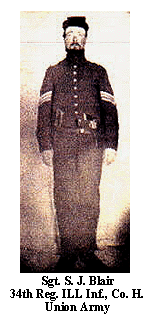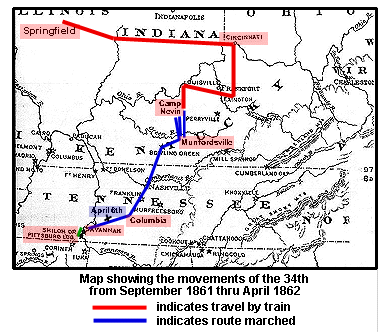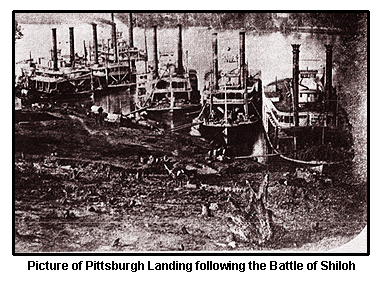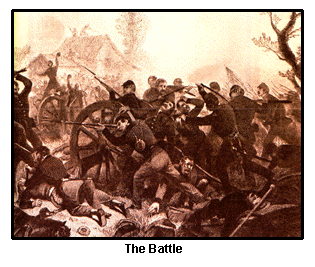Soon after the first shots were fired at Fort Sumter on April 12th, 1861,
President Lincoln called for 75 thousand volunteers to join his new Union Army. In
Northern Illinois, Edward N. Kirk, a prominent attorney in Sterling, Illinois was
authorized by the governor to raise a regiment. This regiment was raised among the men of
the Valley of Rock River in Northern Illinois and became the 34th Illinois Volunteer
Infantry, also known as the "Rock River Rifles." Companies A, B, and part of K
came from Whiteside county; C and D from Lee County; E, F, and H from Ogle County; and I
from Carroll County.
Silas Jackson Blair, David Bell,
David Wagner & Samuel Wilson McClure, along with many of their
neighbors, friends and other relatives left there place of rendezvous at Mt. Morris on
September 9, 1861
 and
traveled via train to Camp Butler, near Springfield, Illinois. The other companies had all
left on the 3rd of September, but Company H’s departure was delayed probably due to
the death of Samuel Blair to whom several in the company were related: Company H was
mustered in on September 12th by Capt. Pitcher and pre-dated to the 7th. The examination
at muster was very informal and none were rejected, a compliment to the robust and
stalwart appearance of the men. The Muster roll described Silas Jackson Blair as a married
male, 28 years of age, 5 feet 7 and a half inches tall with brown hair, blue eyes and
light complexion. His step-cousin and friend, David Bell was described
identically except
for being single and having dark hair. Although commissioned officers were usually
appointed before the mustering of a company, non-commissioned officers were generally
elected by the men themselves soon after mustering. It was at this time that Silas was
elected as a Sergeant in the company by the men who would serve under him.
and
traveled via train to Camp Butler, near Springfield, Illinois. The other companies had all
left on the 3rd of September, but Company H’s departure was delayed probably due to
the death of Samuel Blair to whom several in the company were related: Company H was
mustered in on September 12th by Capt. Pitcher and pre-dated to the 7th. The examination
at muster was very informal and none were rejected, a compliment to the robust and
stalwart appearance of the men. The Muster roll described Silas Jackson Blair as a married
male, 28 years of age, 5 feet 7 and a half inches tall with brown hair, blue eyes and
light complexion. His step-cousin and friend, David Bell was described
identically except
for being single and having dark hair. Although commissioned officers were usually
appointed before the mustering of a company, non-commissioned officers were generally
elected by the men themselves soon after mustering. It was at this time that Silas was
elected as a Sergeant in the company by the men who would serve under him.
The men were uniformed with gray jackets and pantaloons, of better material than was
ever furnished afterwards, but owing to the fact that the Confederate army adopted gray
as the color for its soldiers, blue was adopted by the Federal Army and the regiment was
refitted a few months after its organization.
On the third of October the regiment was put on rail cars and started for Cincinnati,
Ohio. The men rode in stock and box cars with planks set across coal racks for seats. The
regiments historian remarked that "never a train carried a heartier or more willing
set of men than those who, knowing only that orders had been given for their departure,
were now speeding across the country, to some unknown point where their services were
needed, or supposed to be." Upon their arrival in Cincinnati they were transported
across the river to Covington, Kentucky and served a great supper by the citizens of that
neutral state.
From Covington, they started into uncertain territory and a few of the men were issued
firearms, "perhaps on the theory that the less number of guns placed in inexperienced
hands, the less the danger to the regiment as a whole." They arrived in Lexington and
were again supplied generous meals by the citizenry. Here the regiment remained for three
days, encamped in a beautiful blue-grass field near the race track of the city called Camp Sayres.
They left Lexington on October 8th and proceeded to Louisville, Kentucky and from there
to Nolin River about 55 miles to the South. They crossed the "Rolling Fork"
river on a temporary bridge constructed of poles. The engine was detached and crossed
alone and the remainder of the train pushed across by an engine in the rear. The regiment
was momentarily fearful that their military careers might soon come to a premature watery
end. Arriving at Nolin on the 11th at about one in the morning the regiment pitched their
tents in the midst of a chilly downpour. From there Company H and Company I were
detached to act as bridge guards at Elizabethtown. They did not rejoin the regiment until
the 18th, having made a weary march through thick Kentucky mud.
At Nolin River, Camp Nevin was established and Gen. A. McD. McCook was placed in
command of the camp. Three officer’s wife’s accompanied the regiment and
although camp life was very trying they remained for several weeks. Over the next few
weeks the regiments, brigades, divisions and the army itself were organized and
reorganized a number of times until eventually the 34th became a part of the Army of the
Ohio under the command of Gen. Buell; Fifth brigade under the command of Brig. Gen. T. J.
Wood; the thirty-fourth Illinois Volunteers under the command of Colonel E. N. Kirk.
Camp Nevin was set up as the Winter quarters and the men made themselves as comfortable
as the circumstances of soldier life would permit, but the cold rainy weather and the
sudden change in diet, soon manifested itself in disease and looked for a time that it
would be the ultimate killer of the men rather than the bullets of war. By the first of
December, 15 to 20 percent of the regiment were unfit for duty including the regiment's two
doctors.
As the Winter passed the men were engaged in preparations for war. The officers were
schooled in tactics and the volunteers were drilled in the use of arms, bayonet practice
and skirmish drills as well as their other daily duties.
There were three Confederate camps in the same vicinity, one within ten miles of Camp
Nevin. No engagements were brought on but the proximity of the enemy produced a degree of
interested watchfulness on the part of the men.
On December 9th the evacuation of Camp Nevin was begun and by the 17th the troops had
all advanced southward toward Munfordsville, on the Green River. In the advance small
bodies of the enemy were encountered, but no serious resistance was made. The bridge
across the Green River at Munfordsville had been destroyed by the Confederates and because
of high water a great deal of difficulty was encountered in securing a position for a
pontoon bridge. This bridge was to accommodate a few troops who were going to be
positioned on the south bank on outpost duty. On December 17th these men, numbering 414,
were attacked by Col. Terry’s Texan
Rangers, a force of 2000, well disciplined and
experienced officers and men. The Rangers were victorious and of the 414 Union men, 12 were killed
and 28 wounded in the attack, but even heavier losses befell the Rangers with 49 killed
and nearly 70 wounded.
A new winter camp was set up near Munfordsville and troop training continued. Officers
were given examinations and those deemed unfit were asked to resign. Many resigned before
the examination, but in the 34th there was only one such case and those that remained
passed the test. With experience came better conditions, both for the officers and the men
in the ranks, as well as in hospital accommodations, which were frequently required. The
wet winter season was still wearing on the men and the sick list was at times very
discouraging. At one time the entire camp had to be moved to higher ground because the
original site was too low and flat to drain readily
As the winter wore on, rumors of a forward movement of the Gen. Grant’s Army of
the Tennessee, began to reach the camp and the anticipation of active service brought
gratification to those who now considered themselves soldiers fitted for any duty or
emergency. The advance of Gen. Grants army on Fort Henry and Donaldson was the signal for
breaking camp and on the 14th of February, 1862, the men marched, much to their surprise
in the direction of Louisville. The weather was chilly and very cold at night and during
the day the sun turned the slightly frozen ground to thick mud. The going was exhausting
under a heavy load of guns and packs. The first day of the march they made 16 miles and
the following day retraced eight of those heading back in the same direction they had just
come from. On day three they passed by their original starting point and headed towards
Mammoth caves through enough mud "for the creation of a whole nation of people." The troops remained for five days in Mammoth and some took the time to visit the famous
caves. By the 23rd they had arrived at Bowling Green and half expecting to see the enemy,
found that they were gone. On March 3rd they crossed the Cumberland River at Nashville and
established Camp Andy Johnson two miles south of the city which they occupied until the
16th of March. Marching onward they arrived at Columbia, Tennessee on the 23rd of March. They remained there for ten days in order to rebuild the bridge across the Duck River,
which had been destroyed by the retreating enemy. Lt. Col. Bosworth superintended the
rebuilding on the bridge and he recklessly, as the men thought, exposed himself to
personal injury by wading into the stream to set an example to the men who were employed
on the bridgework. He was taken seriously ill and transported to Savannah by ambulance and
then sent home to Illinois where he died soon after.
From Columbia the march was resumed at a leisurely pace and continued so until the
morning of the 6th day of April, when at 9 o’clock in the morning, the boom of heavy
artillery was heard off towards the South, and orders came to hurry forward to Savannah
about 22 miles away.
The 34th at the Battle of Shiloh.
On the 6th of April the confederate Army, led by Gen. Albert Johnston made a surprise
attack on the Union forces of General Grant who were held up at Pittsburgh Landing
awaiting the arrival of Gen. Buell’s Army of the Ohio. The attack came as a total
surprise and after a period of complete confusion on both sides a fierce and deadly battle
ensued with the confederacy eventually taking the upper hand in spite of the death of
their commander Gen. Johnston. Gen. Johnston was the highest ranking officer to be killed
on the battlefield during the entire Civil war.
From a distance of over twenty miles the 34th could hear the battle in progress. Col.
Kirk, who was in command of the brigade, set the men out at a hurried four-mile an hour
pace. Major Levenway who was in command of the 34th due to the illness of Col. Bosworth,
seemed serious and reserved, as if he knew that death was imminent, but he remained cool
and collected. The brigade arrived at Savannah about 11 o’clock on the evening of the
6th and after a long wait in a drenching downpour they were boarded onto steamboats to be
transported to Pittsburgh Landing. Many wounded had been brought down the river to
Savannah, and long rows of white cots were visible in an empty store building as they
marched by, raising in the minds of many the question as to whether or not their lot was
not better than theirs who were yet to take all the chances of battle on the next day.
The men weary from there march of 27 miles during the day, dropped down and were
asleep very soon after boarding the boats, which landed at sunrise on the morning of the
7th of April. They immediately went ashore and marched out toward the scene of conflict
which was already in progress on their left. Gen. Nelson’s division had arrived the
evening before and engaged the enemy to the left and held the ground ready for an attack
in the morning, which had just begun. General Rousseau’s brigade was in advance of
the 34th’s brigade and became engaged with the enemy and had driven them some
distance, while the 34th’s brigade followed as their support until about 11
o’clock, when Rousseau’s ammunition being exhausted, he sent word to Col. Kirk
asking to be relieved.
The 34th’s brigade moved forward steadily and arrived at the edge of a narrow open
field about twenty rods to the rear of Gen. Rousseau’s lines. They halted there until
Gen. Rousseau retired, which he did by the right flank, past the right of the 34th. This
consumed so much time that the enemy had an opportunity to re-form their lines and was
ready for the brigade before they reached the position vacated by Gen. Rousseau. No sooner
had they begun to advance than the swish of canister and the droning of musket balls
began to give the men a new experience, and by the time they had gained the position
lately occupied by Rousseau, "music by the full band was turned on." There was a
slight elevation of ground covered with some underbrush just in front of the two right
companies of the regiment, but the remainder of the regiment and the 77th Pennsylvania on
their left were in the open and in full view of the enemy.
Col. Willich of the 32nd Indiana, marched his regiment forward and asked leave of Col.
Kirk to move his regiment to the front and make a charge. They moved forward, but upon
reaching the slightly elevated ground they received staggering fire from directly in
front, which checked them and caused them to retreat. The withdrawal of the 32nd caused
some confusion in the 34th, which also received the effects of fire directed at the 32nd
in addition to the fire it was already receiving from another battery.
The fierceness of the attack staggered the regiment, and it wavered and might have
been thrown into a panic except for the gallantry and deliberate bravery of Col. Kirk, who,
with the only unwounded member of the color guard (James A. Worrell, of Company A),
advanced the flag and called on the regiment to rally to the color line, which it did with
coolness and deliberation, and maintained the position, pouring a deadly fire into the
enemy with great effect. At about four o’clock the enemy withdrew from the field,
beaten and defeated.
The regiment lost 35 killed and mortally wounded, Silas Jackson Blair and his
step-cousin, David Bell, among them, and 92 wounded. Silas Blair's body was never
recovered, only his head. The brigade retired to the landing and settled for the night,
not having had so much as a cup of coffee since the previous morning. They had put in a
hard and severe day’s duty on the battlefield and now that the battle was over, they
were by reason of rain, deprived of even the warmth of a fire or the ability to make
even a scanty meal. Many just fell to the rain soaked ground and slept where they lay.
The
following day the brigade moved three or four miles toward the front and went into
bivouac, and remained there until the 14th of April.
More than 24,000 men lost their lives during the two day Battle of Shiloh: 13,000
Union soldiers and 11,000 Confederate soldiers. For the 34th, the period of service from
the day of muster-in of the regiment to the engagement in the battle of Shiloh was just
seven months, and the losses and casualties, including those of April 7th and the
resultant deaths, discharges, transfers and details, reduced the effective force of the
regiment by at least twenty percent.
[The above history was summarized from the accounts of Edwin W. Payne, Sgt. Co. A.,
Regimental Historian]
For more information on the 34th or the Battle of Shiloh see the
following sites:
The 34th
Illinois Infantry
The
Battle of Shiloh